Living, sleeping, and just barely scraping by alongside the dead in a Philippine cemetery
Marielle Descalsota

- Several thousand people live in graveyards in the Philippines.
- Homes, eateries, and daycare centers have been made of tombs and mausoleums.
The Chinese Cemetery in Cebu — an island-province in central Philippines — is where dozens of people live in informal settlements.
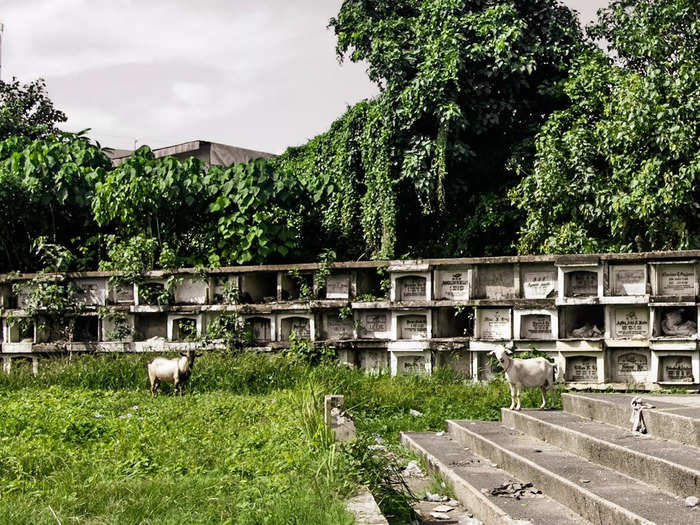
Cebu is the second-largest city in the Philippines, after Manila. It's where the country's richest — and poorest — coexist.
In Cebu, thousands of people live in graveyards like the Chinese Cemetery. Graveyards are turned into informal settlements — described by the Philippine Statistics Authority as a place where people live "without title or right or without the owner's consent whether in urban or rural areas."
Many of these people live below the poverty line. In the Philippines, that's some $293 a month for a family of five. This means that the people residing in these graveyards have no choice but to seek shelter there, as they can't afford to rent elsewhere.
Most of the graves at the Chinese Cemetery, a graveyard where some of Cebu's most highly-esteemed Chinese-Filipinos were buried, are now dilapidated. Dozens of makeshift houses are built in mausoleums that once housed the dead. Food stalls, small businesses, and even a daycare center now operate inside the cemetery that's been turned into a neighborhood.
Insider spent a day with the residents of the Chinese Cemetery, and Carreta Cemetery — another informal settlement just a few minutes away — to learn more about what it's like to live in a graveyard in the Philippines.
Merle Rabacal is a long-time resident of the Chinese Cemetery. She spends her day caring for her children, whom she lives with in a small mausoleum at the entrance of the graveyard.
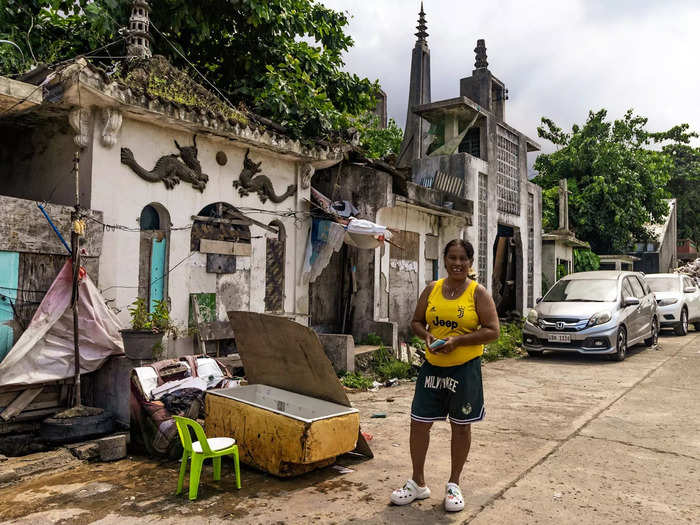
Rabacal's home was built from two mausoleums, which previously housed tombs belonging to several Chinese-Filipinos. The mausoleums beside her home, which were still intact, were decorated with traditional Chinese motifs, like twin dragons and sloped roofs.
The door to her home was made of several tin sheets. Right outside was a makeshift bathtub that was previously used as a cooler.
"My husband is in prison, but I live here with my children. It's OK, I see all these things as temporary," Rabacal said.
Rabacal played with her daughter in the morning, who enjoyed bathing in the tub. Her son, meanwhile, hung out with his friends who also live in the graveyard. Christian songs from the popular band Hillsong blared out of the boombox that she owned.
Rabacal says she's heard of plans to demolish the cemetery. And just several days after Insider spoke to her, these plans were confirmed — the area was going to be turned into a heritage park.
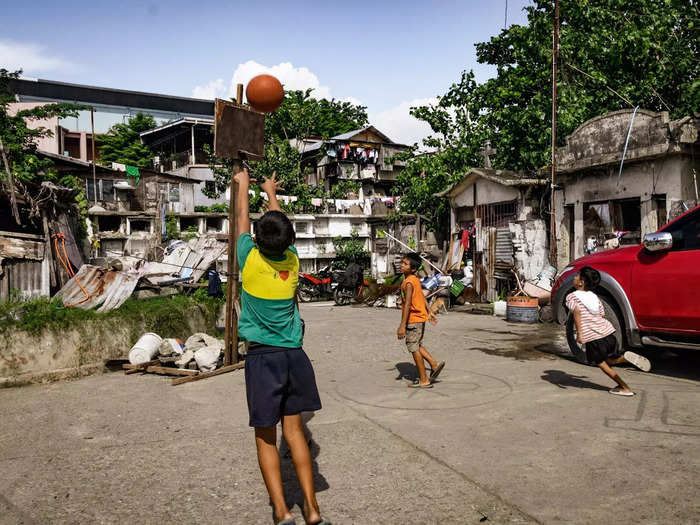
These plans have put many residents' lives, including Rabacal's, into limbo. This means that the families living in the cemetery now face eviction by the local Cebu government, according to the local newspaper The Freeman. The cemetery is set to be turned into a 100-million-peso, or $1.8 million park on July 12, per the report.
Cebu's local government did not respond to multiple requests for comment from Insider.
But Rabacal remains resolute. She says she's been through many challenges, and her faith will help her get through this one.
"I've been a born-again Christian for a year," Rabacal said.
"There are several pastors who have planted a seed to many people here. I believe that I'm here to share the word with others. I've dedicated my life fully to him," she continued.
Rabacal's work is difficult. She helps to remove cadavers from the few remaining tombs there, whether it's for the family to rebury the body elsewhere or to clear it to build homes.
"Nobody gets buried here anymore. We've heard of a plan to demolish the place. But I believe that God has a plan," she said.
Neighbors Neriluz, Genelyn, and Merlia have lived in the cemetery for between 10 to 20 years. They sell popular Filipino street food from a stall in the cemetery.
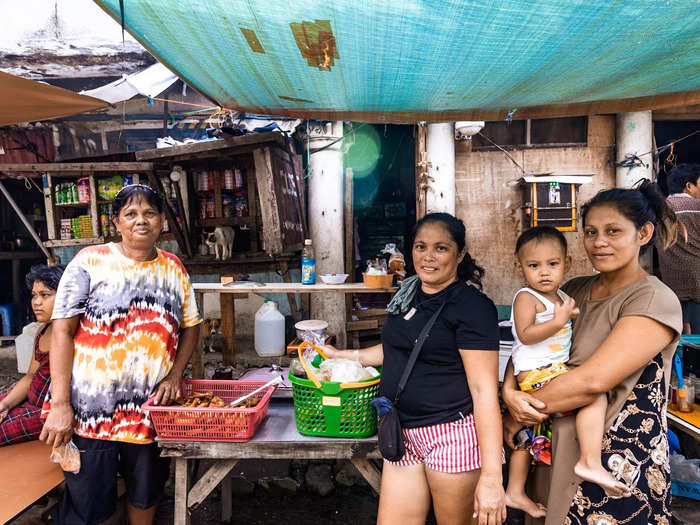
Several clusters of houses were made out of mausoleums deeper inside the graveyard. The streets where these residents lived weren't in the best condition. Black water had gathered on the cracks that had formed over the unpaved ground, and trash had accumulated right on top of it. The stench of the polluted water permeated the air.
In one of these streets, Neriluz, Genelyn, and Merlia ran a small stall where they sold Filipino snacks like lumpia — a crunchy dish made with wrappers and meat, isaw — grilled intestines with soy sauce, and bola-bola — noodles with meatballs and vegetables. They greeted each of their customers with a bright smile.
"It's hard to live here. Sometimes you have food to eat, and sometimes you don't. If you don't sell anything, you won't survive. Sometimes you have to resort to taking on debt," Neriluz, 41, said.
Each of the snacks costs 10 pesos or 18 cents. But Neriluz still needed to borrow 1,200 pesos, or $21, to prepare the food she was selling, she said, as running the business had been tough. She often makes a profit of 200 pesos, or $3.50, which is enough to feed her family for the day.
But there are times when opportunities are few and far between, Neriluz said. Sometimes her family only has enough to eat once a day, she added.
"Some people end up leaving when their children have gathered enough money. But for us, it's not possible yet because our children are still young. I hope to work hard until we can leave," Neriluz continued.
But Neriluz said it's not all gloom living in a cemetery — they all have a strong bond with each other.
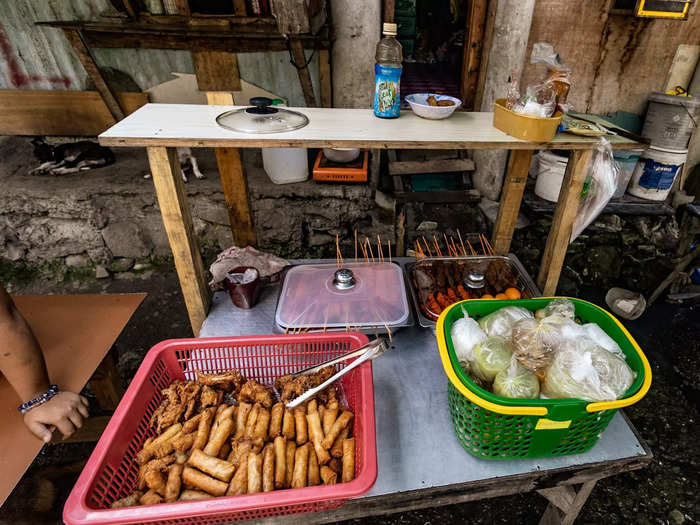
The community in the cemetery is built on trust, Neriluz said. In fact, when she's off running an errand, Melia and Genelyn help take care of her stall. Genelyn, in particular, has lived in the graveyard since she was a child.
Neriluz's customers are their neighbors too, who usually drop by her stall for lunch. Despite the difficulties of living in a graveyard, she said many of them are still smiling thanks to the kindness of some of her neighbors like Melia and Genelyn.
"The best part about living here is the community. We have a camaraderie here, a strong friendship," she said.
Roselyn and Rosemarie Aquino are sisters who have lived in a house made out of a mausoleum for 13 years. They sell snacks in their mini convenience store to make a living.
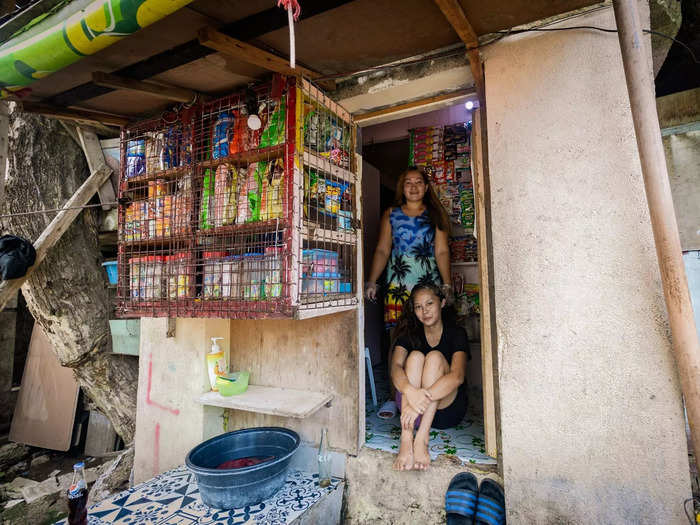
The sisters run a sari-sari store, which refers to a family-run convenience store in the Philippines. Roselyn also colors hair on the side, and on that day, she was busy fixing up her sister's hair.
"I wake up at 5 a.m. to help my kids get ready for school," Roselyn, a mother of three, said. She added that her businesses make "enough for them to get by."
In her free time, she watches videos on the popular social media platform TikTok. There, she posts clips of herself dancing to some of the trendy songs. To her, it's an escape from living in a cemetery.
"Dancing on TikTok is the happiest part of my day. My children are proud to see me there, and they imitate me when I'm dancing too," she said.
Elvera and Diktor Uliyamot were some of the first people to live in the cemetery. The couple have lived there for more than 40 years — right when the land was reclaimed from the ocean.
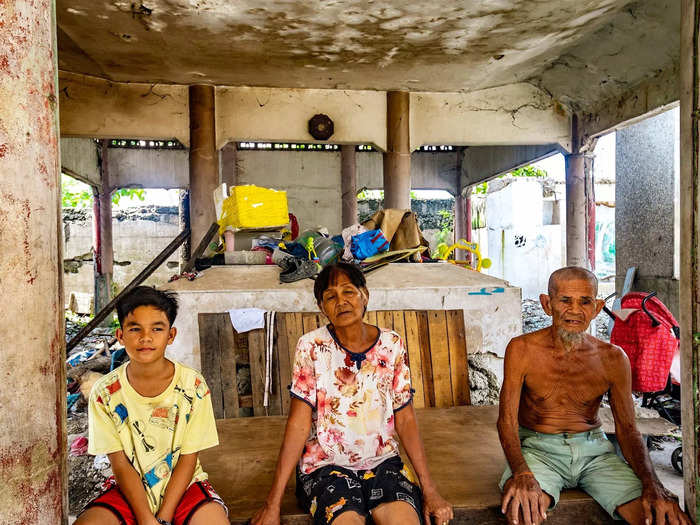
Elvera was in her 20s when her parents moved to Carreta to take care of the cemetery. She remembered picking up seashells and clams for food. Now, things are different — there aren't many remnants of the sea. The cemetery is also not a place where people get buried anymore.
The reclamation of land in North Cebu, where Carreta is located, began in 1962, according to an October 1980 report by the Philippine Planning Journal. About 91,750 square miles of land were used to build cemeteries, per the journal.
"Now, many of the cadavers have already been reburied somewhere else, so we have not much to take care of. So my husband builds houses out and about here," Elvera said.
The couple met in the cemetery in 1972 and got married six years later. They have three children together, and several grandchildren, including a 14-year-old boy named Adrian, who also lives in the cemetery.
The cemetery's transformation into an informal settlement was one of the biggest changes in the area, Elvera said. Many things — from the tombs to the structures built around them — have fallen into disrepair.
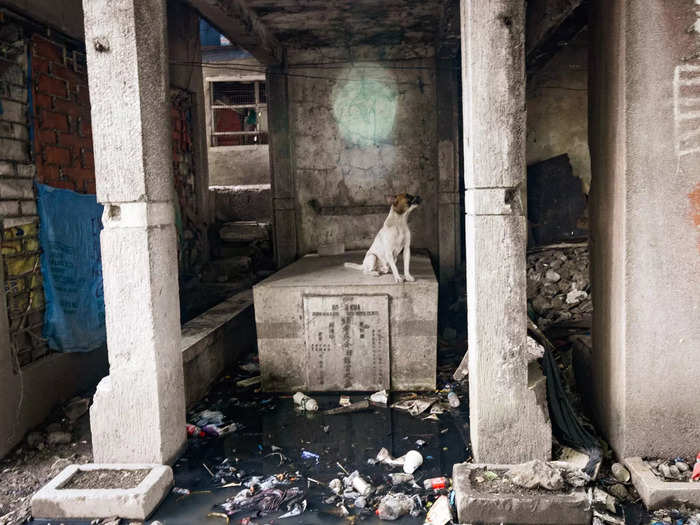
On the street where the couple lives, concrete had piled up on top of tombs where bodies were once buried. Old, black and white photographs still hung on the blackened walls, while several belongings were scattered about. In one of the dilapidated mausoleums, a dog sat on top of a tomb, surrounded by plastic garbage and vandalized walls.
"We've stayed here because it's peaceful. But now there are many squatters, it's changed," Elvira said. She added that she and Diktor had stayed put, believing that it would always remain that way.
"Last time it was only us and the guard of the cemetery. We slept soundly, but now since there are many residents, I've felt like our peace is disturbed," she added.
Annabelle Amparo is the caretaker of a children's daycare center in the cemetery. She's been volunteering there for more than 10 years.
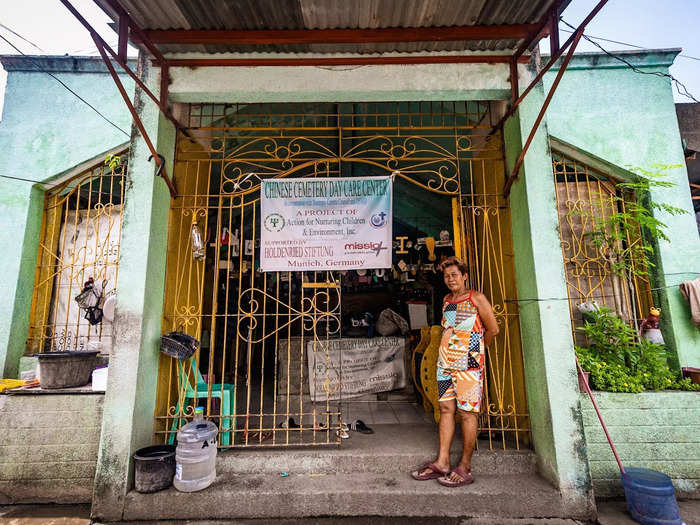
Ampara said the daycare center was started by a man from Germany and a local priest who wanted to help the people living in the cemetery. In the Philippines, this is called a "sponsor" — a person who helps out financially to people in need, and they are mostly based overseas.
Some 70 children living in the cemetery attend the daycare, Amparo said, but there's only one volunteer teacher to teach all of them. She wanted to help the teacher, so she volunteered to care for the children and keep the daycare clean.
"My grandkids attend the daycare too. I started helping because I pitied the teacher, who lives really far away. When the teacher comes, everything is ready," Amparo said, adding that she's "kind of the teacher's assistant."
The daycare center itself is built from a large mausoleum that's big enough to house dozens of children. It resembles an actual home, more than anything.
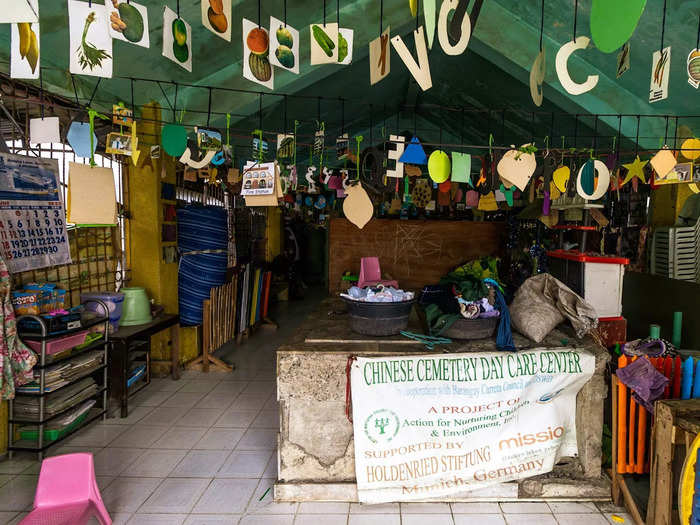
Inside, photographs of fruit were hanging from the ceiling. Charts and school supplies decorated the walls, and there was even a makeshift stage. Several children were playing hide-and-seek, laughing heartily, with their feet thumping on the ground.
Amparo said she lives in the daycare, and that she spends most of her time just caring for the children. She added that everything is taken care of, from the children's food and clothes to their stationery for school.
"I just want to make sure that someone looking after them, especially as their parents are busy working elsewhere," Amparo said.
The Carreta Cemetery is one of the largest public graveyards in Cebu. It's sprawling, located behind a makeshift dumpsite, and surrounded by towering urban buildings.
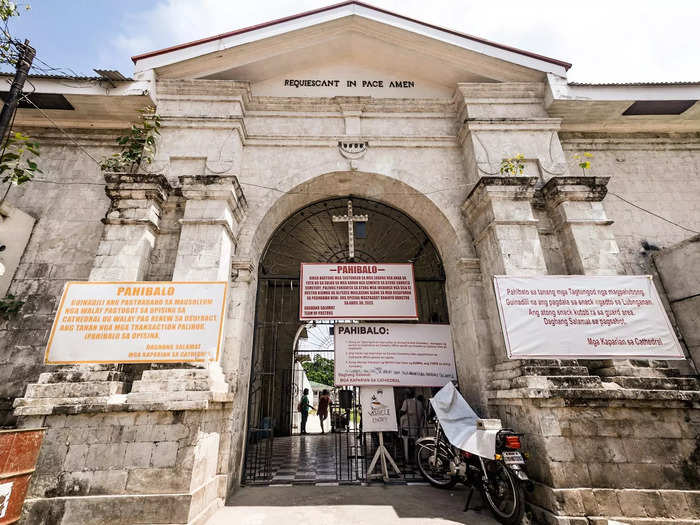
Carreta Cemetery was much busier and just a few minutes away from the Chinese Cemetery. There was a certain energy about the place, with people peddling everything from candles to trinkets on every car that passed by the bustling street. It was crowded too, with people running in and out of the graveyard, bringing in caskets, as family members followed closely behind, crying.
It's one of the largest informal settlements in any graveyard in Cebu. People live inside and outside the graveyard, with makeshift houses made from wood and tarpaulin sheltering dozens of people.
On All Souls' Day on November 1, when Filipinos celebrate their dead loved ones, the graveyard lights up with candles.
Insider arrived on a hot afternoon and there wasn't an air of festivities, but more a lull of people waiting patiently for time to pass by.
Virginia is one of the residents who sells candles to visitors for a living. She lives in a house covered in tombstones right outside the cemetery.
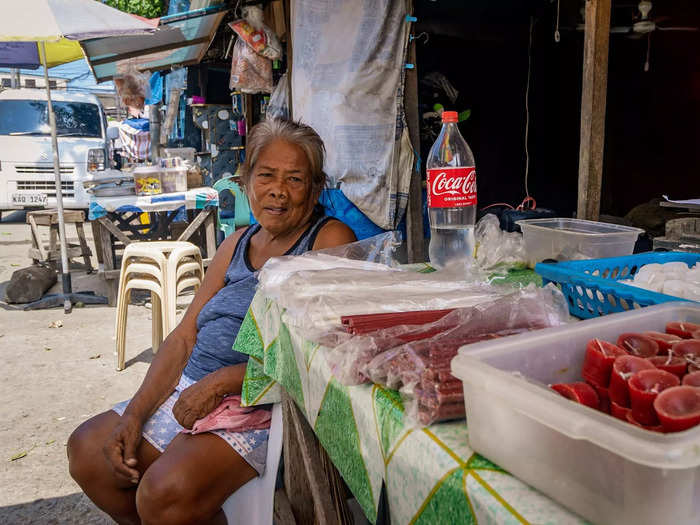
Virginia said her parents also sold candles, and so that's the kind of work she's known her whole life. It's been three generations of her family living in the graveyard, as her six sons also grew up in the cemetery. One of them, Nelson, still lives with her and makes a living building and engraving tombstones.
"We live — and die — here," Virginia said of her family, adding that she can't leave the cemetery as she's already built her candle business there.
Living there is far from easy, but natural disasters have made it even more difficult for Virginia. She used to own a sari-sari store right beside this home, but then it was destroyed when the Odette typhoon wreaked havoc on the Philippines in December 2021. More than 400 people were killed and some $1 billion in damages were incurred during the typhoon.
"Since then, we had to live in a simple shack. We didn't receive any aid," she said.
Virginia's home is made out of some wood and a plastic covering. It's hot, noisy, and very dusty — and barely protects her and Nelson from the elements.
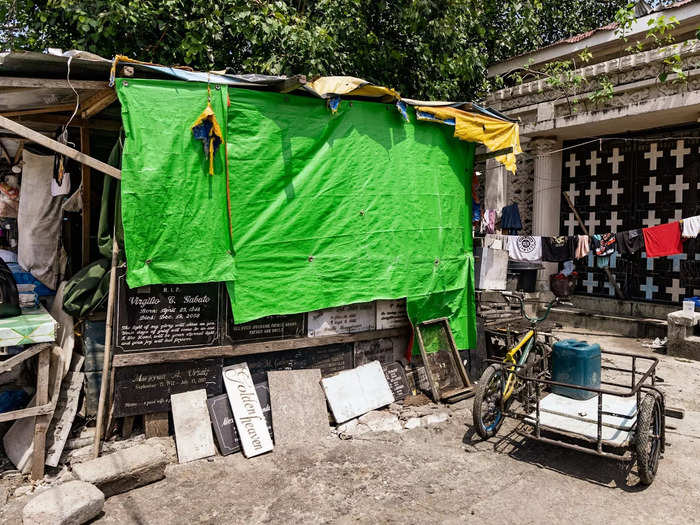
Virginia said they often take shelter inside the cemetery whenever it storms. She said that the structures inside are much stronger and can protect from the wind and rain. But outside, where they live right next to mausoleums covered in crosses, they only have their marble tombstones to keep them safe.
These tombstones have been a lifeline for Virginia and Nelson. They sell one tombstone for at least 3,500 pesos, or $62, each. All the pieces are handmade by Nelson.
Virginia said that she's heard of plans for Carreta to be demolished and turned into a building. While there have been no official announcements from the local government regarding an eviction, it worries them.
"I don't have anywhere else to go, nor do I have work outside of selling candles to people at the cemetery," she added.
Fe Liloan operates several businesses inside the graveyard. She spends her day selling food and candles, as the hot sun basks over the thousands of tombstones that surround her.
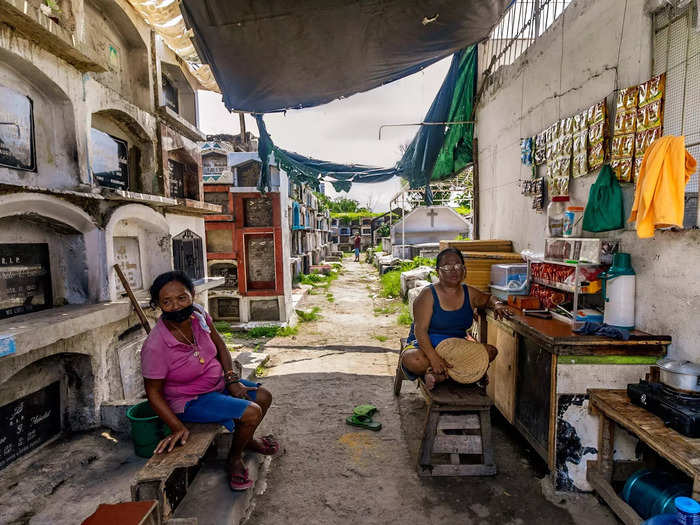
Liloan had set up her sari-sari store beside a wall of small tombs. A shade blocked the sun overhead as several packets of food hung on an adjacent mausoleum. Her store was complete with a stove to heat some instant noodles for customers.
"People working and living around the cemetery frequent my shop," Liloan said, adding that she has been living in the graveyard for three years. She said she sells a "package" to people visiting the dead — she would clean tombstones while giving them food to eat, as well as prepare candles for them to remember their loved ones.
Liloan said that living in a graveyard is all about survival and looking for opportunities to make some money to take care of herself and her children.
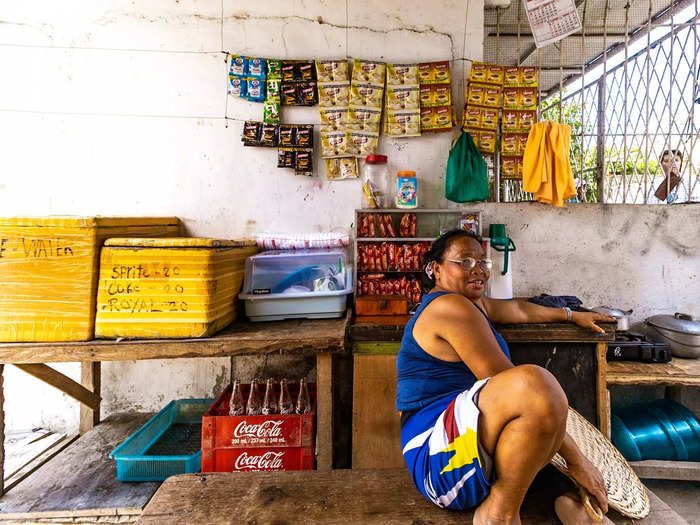
As grim as it sounds, Liloan said that living in the cemetery has taught her how much people rely on the dead to survive.
She's been married twice, she said, and has six children, including one child whom she adopted. She sells noodles, Coca-Cola, and coffee at her store in the graveyard every day — where one bowl of instant noodles costs 10 pesos, or 18 cents so that she can provide for her family.
"The only thing that's good about living here is that we can make some money," she said.
"When there's no dead people, we don't have a livelihood — and no one buys our candles," she added.
Popular Right Now
Popular Keywords
Advertisement